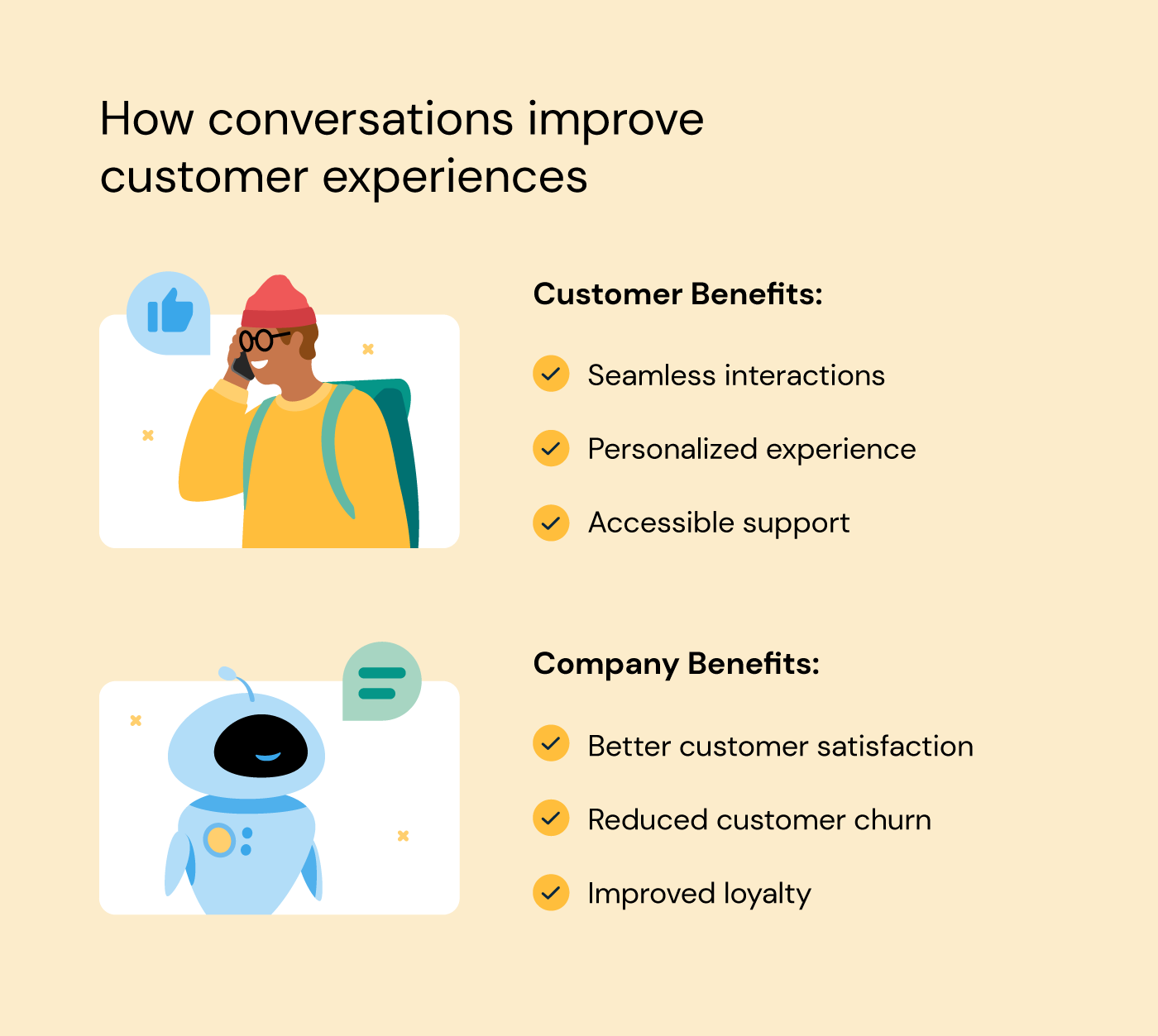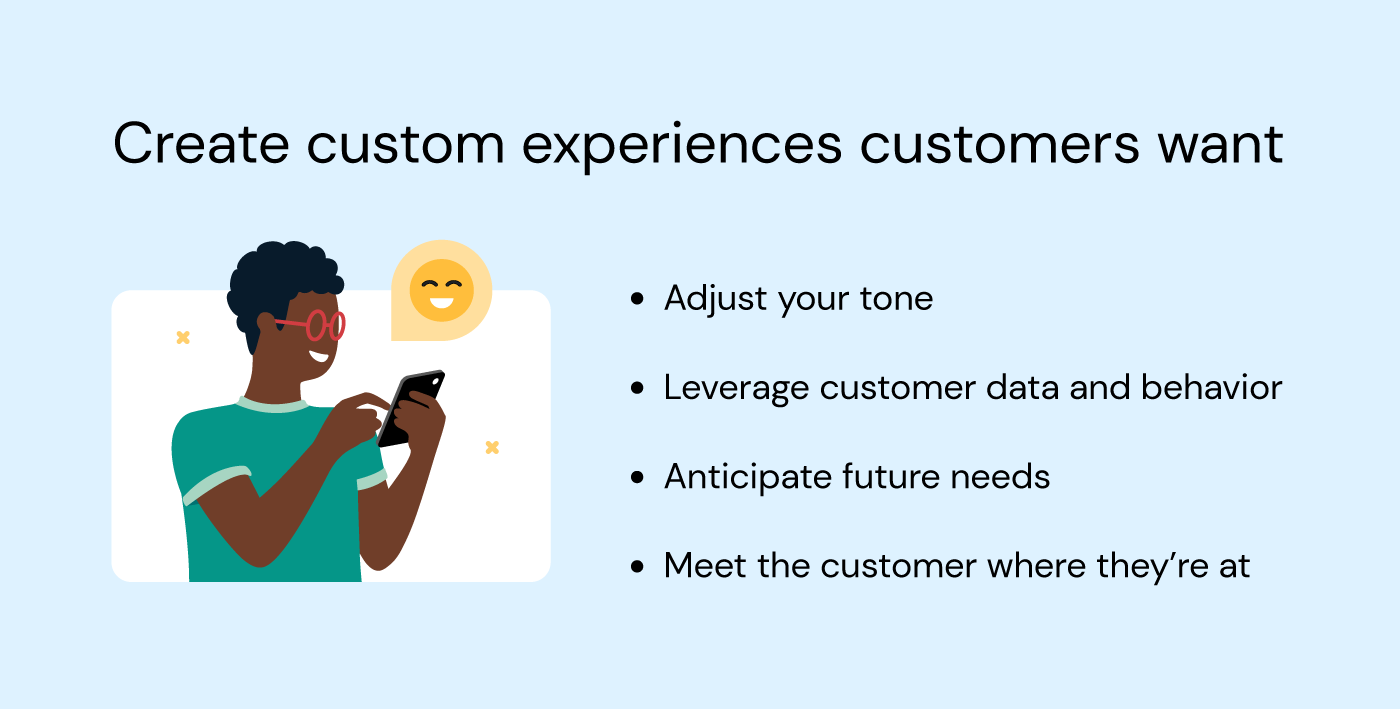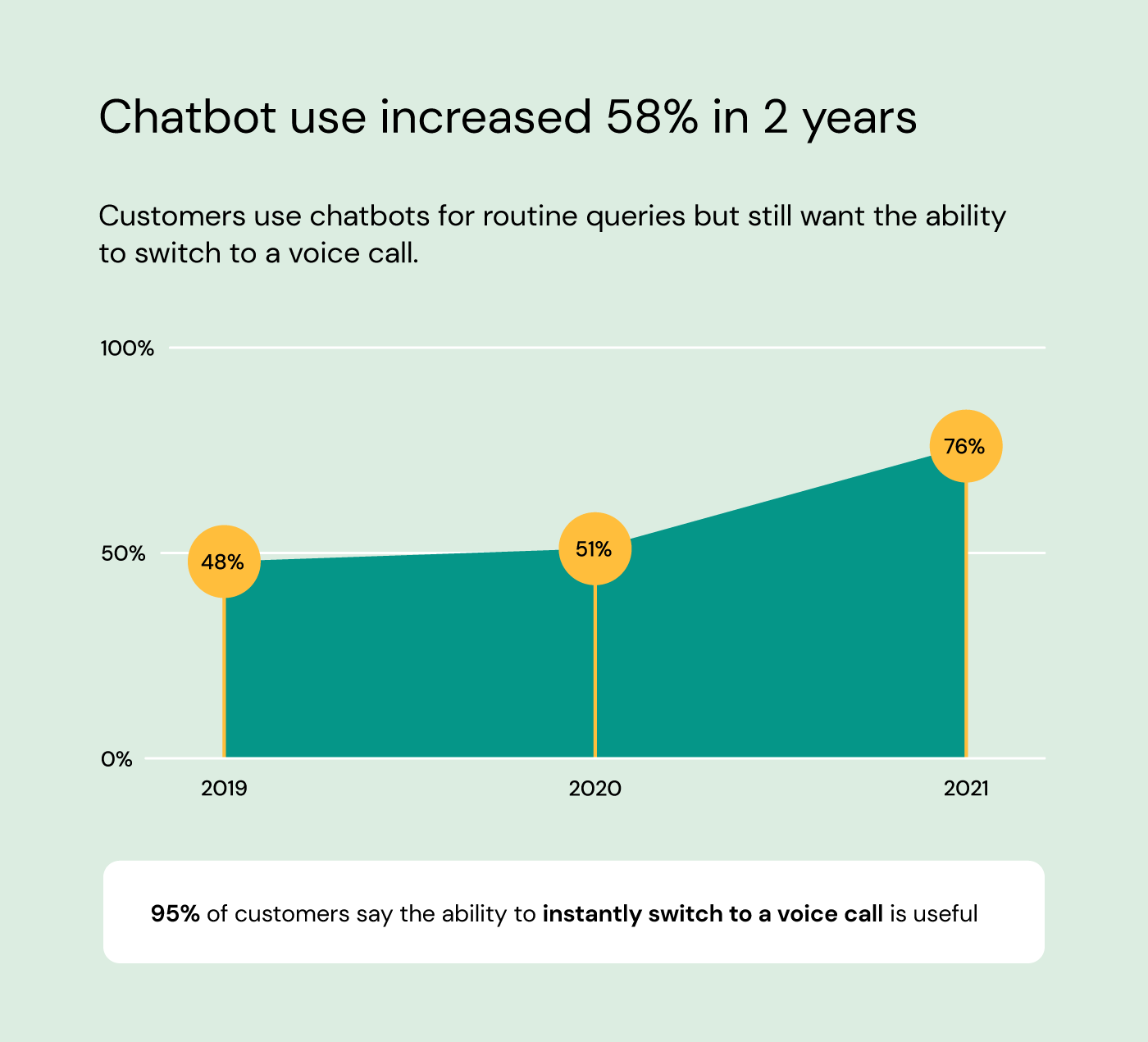Insights
Conversational customer service: Tools and tips to build lasting relationships

Insights

Did you know that 65% of customers find positive customer experiences more influential than great advertising? In fact, 73% of customers stay loyal after a positive experience.
That’s why companies invest billions in chatbots, AI technology, and customer research each year. What this research reveals is the value of frictionless conversational customer service.
Internally, companies understand that their mobile ads are designed by third-party agencies, their customer chats are answered by bots, and that the live agent consults the sales team to learn more about an account.
But the customer is oblivious to all this. They are having a single conversation through all of these interactions – when they identify value in your services, ask for more information, enter the sales funnel, and follow up about a new product or feature they’d like to try.
Conversational customer service creates a seamless interaction to uplift the customer’s overall experience. This guide will cover how new technology personalizes customer experiences via accessibility and customer data to increase loyalty. Ultimately, this means your customers develop an emotional bond with your brand and may even act as brand ambassadors for you.

Conversational customer service uses technology to manage interactions naturally and prioritize the customer’s preferred experience. This is especially important for businesses where customer experiences have a direct impact on purchasing decisions, like healthcare, banking, retail, and hospitality.
This service organizes customer data and support functions so that it can engage multiple internal departments over several interactions in a way that feels like a single, helpful conversation to the customer.
Current AI technology can evaluate customer data and apply its insights to their specific query and interaction, creating a personalized experience. This can look like following up on a previous request or recommending additional services based on their needs.
For example, let’s say a customer has questions about a product they bought and searches the company to get an answer. They may find chatbots on the site, social media accounts with direct messaging available, a mobile engagement app, and an email address.
The customer can engage with your business on the channel they prefer. Now let’s say they message a chatbot and verify their information, but their specific query requires a live agent to take over. The live agent also has access to the chat logs and identity verification, so they can immediately start assisting rather than re-asking the same questions and frustrating the customer. Remember, a positive customer experience goes a long way.
|
Traditional Support |
Conversational Support |
|
|
Traditional customer support teams don’t always have the resources to focus on customer needs over completing a service ticket. They lack the tools and resources that can empower them to create personalized conversations as part of a solution. Additionally, there are often limited options for customers to access support when companies rely on live agents, with fewer communication channels and hours available.
These constraints add up to a negative customer experience, where agents have to bounce customers to other lines of service or repeat questions. Live agents and outdated automations may also push cookie-cutter responses that can leave customers feeling unfulfilled.
Rather than checking boxes, conversational customer support removes this friction by identifying the customer’s needs on the channels they prefer. Customer-centric businesses understand that the customer doesn’t want to be on hold all day, so they build their service around the customer.
Managing and evaluating internal requests and customer data actually helps customers and provides a personalized experience. It’s also widely accessible, with omnichannel services available for talk, text, and so much more. These features create a single voice and touchpoint for customers to interact with.
Highly satisfied customers become repeat customers, and they spread the word to their friends and families. In fact, customers with a positive interaction will tell nine others, while those with negative experiences tell 16 others, so keeping things positive is key to your business’s growth.
Having a conversation is crucial for customers across a variety of industries – a staggering 89% want two-way conversations via messaging channels. A huge majority of customers (90%) are looking for support, while 89% are looking for returns or refunds.
Customers also benefit from a smooth and personalized service experience. They can get answers quickly and communicate through their preferred channels. This reduces friction, creating positive engagement and brand loyalty.
For businesses, conversational support reduces customer churn and improves customer lifetime value. This also translates into higher NPS and satisfaction scores for your service teams.
Before you put conversational customer service into practice for your business and customers, however, you should get a little prepared. Check out these tips to see how your business can get it right.
Build a customer journey map using customer data and behavior research, identifying how customers are introduced to and engage with your business.
Understanding the customer’s perspective as they learn about your brand is a great way to identify their needs and improve customer service efficiency.
This also feeds into the concept of customer journey management, which uses customer data and analytics, behavior, and engagement to support customer relationships.
When you know where a customer has been and where they’re going next, it’s easier to offer tailored assistance.

Account history and customer journey insights are great places to get context for a customer’s needs so you can apply it to every interaction. Information including previous service tickets, recurring issues, and recent orders can all provide clues to help solve the customer’s immediate needs and anticipate their next request.
Omnichannel experiences that allow customers to engage through multiple mediums also lets them customize their experience based on preferences. Then, you can follow up with personalized offers and recommendations based on the customer’s data via their preferred channel.
For example, the French supermarket chain Intermarché wanted to boost engagement and decided to use a popular recipe section of their newsletter. Users who clicked on recipes were brought to a chatbot that asked about their eating habits and preferences to generate personalized recipe recommendations. This was part of a campaign that grew AI chatbot engagement to 59%.
Personalization isn’t just a good way to promote your business. A majority of customers want personalized messages, including 69% of Gen Z customers.
With Sinch’s Conversation API, you also get analytics to understand which channels customers use most frequently, so you can focus on those channels and create marketing strategies that work.
Omnichannel services meet your customers where they like to chat – whether that’s Instagram direct messages during lunch or a phone call on the drive home. These services are convenient and improve accessibility for people with busy schedules or different communication needs.
Nissan learned how rich SMS messages generated 4.7 times engagement. The brand partnered with Sinch and Adobe to create personalized campaigns that reached over 200,000 customers via their car, text, and mobile app, earning an 80% engagement rate in six months.
While you may have multiple communication channels available for customers, it’s also important to make sure they’re integrated through a single support service. This means customers can begin an interaction via email then switch to WhatsApp and still receive the same top-tier support across channels.
With so many ways to chat, you never know which channel your customers will prefer, so investing in smart customer service across the board is always a good idea.
Key performance indicators (KPIs) are metrics that help determine success and effectiveness. There are a number of KPIs you can use to measure your customer service interactions, including:
You may already have your core KPIs identified, but it’s important to regularly review them to identify opportunities and obstacles in your customer journey. Another benefit of support services is that they automatically track these KPIs and compile them into reports for smooth internal operations and oversight.
A warm welcome and casual conversation puts customers at ease and allows your company to build trust with them. Great AI and well-trained representatives are some of the best investments you can make toward excellent customer service experiences.
Even when customers chat with a bot, a conversational tone and transparency are important. Bots represent your company and should be given branded assets like tone, style, and even a name to work with and build trust. Consult a professional conversation designer to create engaging and natural conversations.
No matter how friendly and efficient your chatbot is, some people will prefer a live agent, and it’s good to give customers that option. Live agents should maintain a warm tone and honesty throughout the interaction. It’s also important that live agents feel comfortable customizing the experience using customer data and interaction history to adjust the conversation and tone.
Accessible support via various communication channels, like social media or SMS, streamlines the customer support process and meets clients where they are.
Nobody wants to be waiting on the customer service line for hours. Chatbots can troubleshoot a number of issues automatically, like customer location or age, for quick and efficient service 24/7. AI-based chatbots take it a step further and can provide full service support for complex requests like rescheduling an appointment.
Chatbots support live agents by assessing the customer’s needs and pre-qualifying requests before transferring them. In some cases, they can handle simple queries so live agents can focus on meaningful conversations to build loyalty and lifetime value.

With Conversation API, you can turn on Smart Conversations, which lets you respond quickly and resolve a customer’s questions or issues before they become frustrated with a chatbot.
Conversational customer service uses AI technology and omnichannel services to provide personalized support to customers when they need it most. It goes beyond the customer service ticket to ensure customers have a seamless experience in a single engagement, rather than bouncing between chatbots and FAQ pages.
Interested in true customer engagement? Connect through conversations to help your customers find exactly what they’re looking for and double your sales with conversational care.